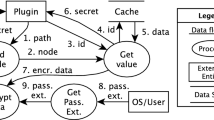Abstract
Growing security requirements for systems and applications have raised the stakes on software security verification techniques. Recently, model-checking is settling in the arena of software verification. It is effective in verifying high-level security properties related to software functionalities. In this paper, we present the experiments conducted with our security verification framework based on model-checking. We embedded a wide range of the CERT secure coding rules into our framework. Then, we verified real software packages against these rules for purpose of demonstrating the capability and the efficiency of our tool in detecting real errors.
Preview
Unable to display preview. Download preview PDF.
Similar content being viewed by others
References
Hadjidj, R., Yang, X., Tlili, S., Debbabi, M.: Model-checking for software vulnerabilities detection with multi-language support. In: PST 2008: Proceedings of the 2008 Sixth Annual Conference on Privacy, Security and Trust, pp. 133–142. IEEE Computer Society, Washington (2008)
CERT Secure Coding Standards (April 2009), http://www.securecoding.cert.org
Reps, T., Schwoon, S., Jha, S., Melski, D.: Weighted pushdown systems and their application to interprocedural dataflow analysis. Science of Computer Programming 58(1–2), 206–263 (2005); Special Issue on the Static Analysis Symposium 2003
Novillo, D.: Tree-SSA: A New Optimization Infrastructure for GCC. In: Proceedings of the GCC Developers Summit3, Ottawa, Ontario, Canada, pp. 181–193 (2003)
Coverity: Coverity Prevent for C and C++, http://www.coverity.com/main.html
Bishop, M., Dilger, M.: Checking for Race Conditions in File Accesses. Computing Systems 2(2), 131–152 (1996)
Specification for safer, more secure c library functions. Technical Report tech. report ISO/IEC TR 24731, Int’l Organization for Standardization (September 2005), http://www.open-std.org/jtc1/sc22/wg14/www/docs/n1135.pdf
Chen, H., Wagner, D.A.: MOPS: an Infrastructure for Examining Security Properties of Software. Technical Report UCB/CSD-02-1197, EECS Department, University of California, Berkeley (2002)
Ashcraft, K., Engler, D.: Using Programmer-Written Compiler Extensions to Catch Security Holes. In: SP 2002: Proceedings of the 2002 IEEE Symposium on Security and Privacy, pp. 143–159. IEEE Computer Society, Washington (2002)
Hallem, S., Chelf, B., Xie, Y., Engler, D.: A System and Language for Building System-Specific, Static Analyses. In: PLDI 2002: Proceedings of the ACM SIGPLAN 2002 Conference on Programming Language Design and Implementation, pp. 69–82. ACM, New York (2002)
Henzinger, T.A., Jhala, R., Majumdar, R., Sutre, G.: Lazy Abstraction. In: POPL 2002: Proceedings of the 29th ACM SIGPLAN-SIGACT symposium on Principles of Programming Languages, pp. 58–70. ACM, New York (2002)
Clarke, E., Kroening, D., Sharygina, N., Yorav, K.: Predicate Abstraction of ANSI-C Programs Using SAT. Formal Methods in System Design 25(2-3), 105–127 (2004)
Ball, T., Rajamani, S.K.: The slam project: debugging system software via static analysis. SIGPLAN Not. 37(1), 1–3 (2002)
Viega, J., Bloch, J.T., Kohno, Y., McGraw, G.: ITS4: A Static Vulnerability Scanner for C and C++ code. In: ACSAC 2000: Proceedings of the 16th Annual Computer Security Applications Conference, p. 257. IEEE Computer Society, Los Alamitos (2000)
Fortify Software. Rats - rough auditing tool for security (April 2009), http://www.fortify.com/security-resources/rats.jsp
Author information
Authors and Affiliations
Editor information
Editors and Affiliations
Rights and permissions
Copyright information
© 2009 Springer-Verlag Berlin Heidelberg
About this paper
Cite this paper
Tlili, S., Yang, X., Hadjidj, R., Debbabi, M. (2009). Verification of CERT Secure Coding Rules: Case Studies. In: Meersman, R., Dillon, T., Herrero, P. (eds) On the Move to Meaningful Internet Systems: OTM 2009. OTM 2009. Lecture Notes in Computer Science, vol 5871. Springer, Berlin, Heidelberg. https://doi.org/10.1007/978-3-642-05151-7_12
Download citation
DOI: https://doi.org/10.1007/978-3-642-05151-7_12
Publisher Name: Springer, Berlin, Heidelberg
Print ISBN: 978-3-642-05150-0
Online ISBN: 978-3-642-05151-7
eBook Packages: Computer ScienceComputer Science (R0)




